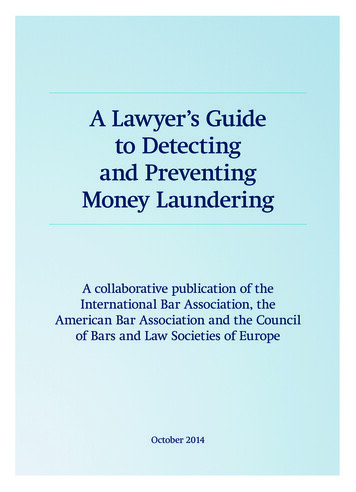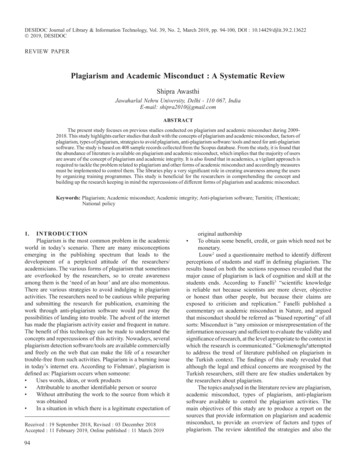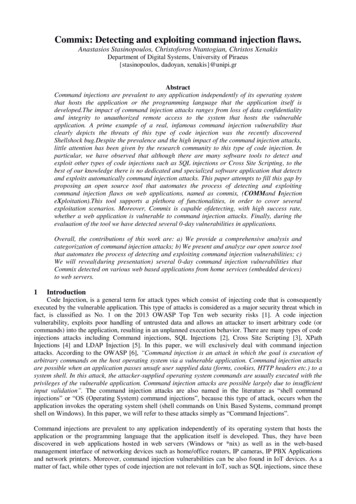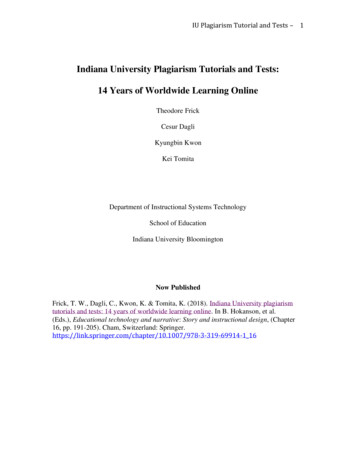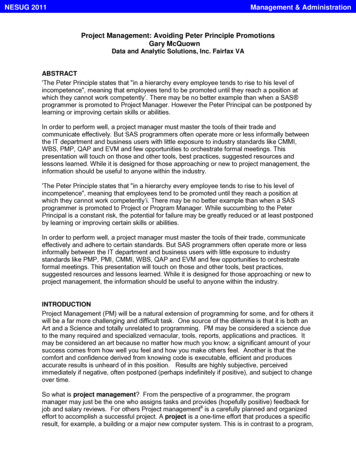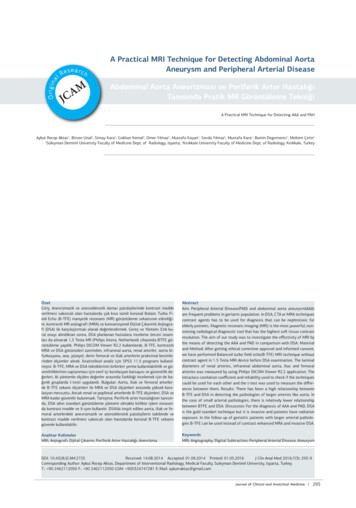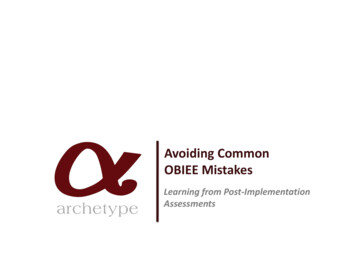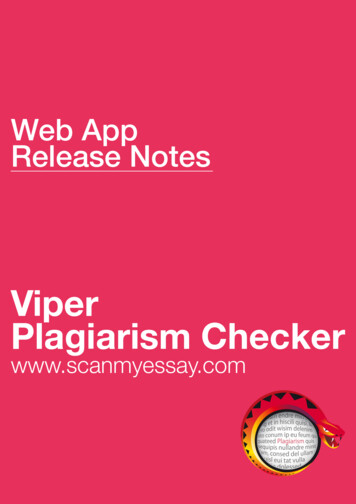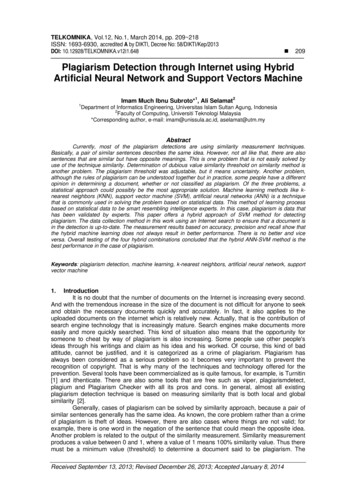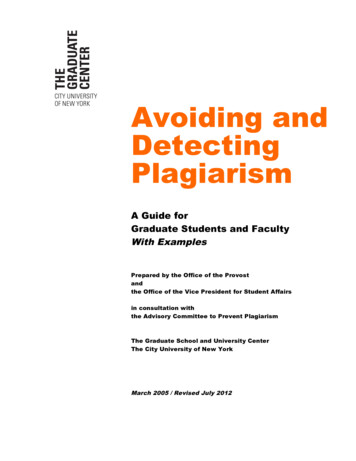
Transcription
Avoiding andDetectingPlagiarismA Guide forGraduate Students and FacultyWith ExamplesPrepared by the Office of the Provostandthe Office of the Vice President for Student Affairsin consultation withthe Advisory Committee to Prevent PlagiarismThe Graduate School and University CenterThe City University of New YorkMarch 2005 / Revised July 2012
AcknowledgmentsWe owe thanks to a number of people and institutions who contributed to thisguide.First, to faculty, student, and administrative members of the 2005 AdvisoryCommittee to Prevent Plagiarism of the Graduate Center CUNY: Linda N.Edwards, Matthew G. Schoengood, James Drylie, Anne Ellis, Thomas Kessner,Sharon Lerner, Peter Lipke, Rolf Meyersohn, Herbert Saltzstein, Lía Schwartz,and Julia Wrigley.Second, special thanks to Anne Humpherys and Sharon Lerner for help in writingsections of the 2005 edition of this guide and to Rosamond W. Dana, BarryDisman, and Jane E. House for help in editing and design. The original design hasbeen followed in this 2012 revised version, which was prepared in the Office of theVice President for Student Affairs by alumnus Christopher Leydon (ComparativeLiterature, 2010), under the direction of Sharon Lerner, director, Office of StudentAffairs, and with assistance from doctoral student in English Cori L. Gabbard.Third, thanks to the following institutions for permission to quote extensively fromtheir websites:Capital Community College, Hartford, sm.shtmlNorthwestern University, Evanston, ts/integrity/This document is available at http://www.gc.cuny.edu/CUNY AvoidingPlagiarism.pdf?ext .pdf.
AVOIDING AND DETECTING PLAGIARISMA GUIDE FOR GRADUATE STUDENTS AND FACULTYWITH EXAMPLESCONTENTSForewordPage 1SECTION I: FOR THE STUDENTPart 1.Part 2.Part 3.Part 4.Part 5.IntroductionPageWhat Is and What Is Not Plagiarism?*PageExamples of Different Kinds of Plagiarism**PageDirect PlagiarismThe MosaicParaphraseInsufficient AcknowledgmentPlagiarism in the SciencesPageHow to Avoid Plagiarism**PageGuidelines for Proper AttributionExamples of Materials which Have Been Appropriately Cited3471213SECTION II: FOR THE INSTRUCTORPartPartPartPart1.2.3.4.Detecting PlagiarismSources for Detecting PlagiarismDoctoral Faculty ResponsibilityProcedures to Be Followed in Instancesof Allegations of Academic DishonestyAPPENDIX I: How to Cite Research Sources Appropriately:Selected ResourcesPart 1.Internet ResourcesPart 2.Sources for Citing Government DocumentsPart 3.Style Guides Accessible via the Mina Rees Libraryor the CUNY Library SystemPart 4.Citation ManagersPage 19Page 19Page 19Page 21Page 23Page 24Page 25Page 26APPENDIX II: Graduate Center Policy on Academic HonestyPage 27APPENDIX III: CUNY Policy on Academic IntegrityPage 29APPENDIX IV: Faculty Report Form for Alleged ViolationsPage 33* Taken in part from the Capital Community College website** Taken from the Northwestern University website
FOREWORDThe goal of this guide is to help answer the following questions: What is plagiarism and how can one identify it? What are the Graduate Center / CUNY policies and procedures with respect toplagiarism and other forms of academic dishonesty? What are the consequences for violating the rules of academic honestythrough acts of plagiarism or other failures of academic honesty? How can plagiarism be avoided? What is the proper way to cite a variety of sources? What are the responsibilities of faculty in response to violations of the rulesfor academic honesty? What resources are available to faculty for identifying plagiarism when it doesoccur?Academic honesty is fundamental to the mission of all institutions of highereducation. The importance of this issue at CUNY was underscored by the issuance ofa report in Spring 2004 by the CUNY Committee on Academic Integrity, the goal ofwhich was to “establish a culture of academic integrity across all campuses.”1 Thisgoal was reaffirmed by the revised “Policy on Academic Integrity,” which took effecton July 1, 2011.2 The Graduate Center has long had a well-established policy onacademic honesty, reaffirmed in every issue of the annual Student Handbook, whichcomplies with the CUNY Policy on Academic Integrity but is tailored to GraduateCenter students:The Graduate Center of the City University of New York is committed tothe highest standards of academic honesty. Acts of academic dishonestyinclude—but are not limited to—plagiarism (in drafts, outlines, andexaminations, as well as final papers), cheating, bribery, academic fraud,sabotage of research materials, the sale of academic papers, and thefalsification of records. An individual who engages in these or relatedactivities or who knowingly aids another who engages in them is actingin an academically dishonest manner and will be subject to disciplinaryaction in accordance with the bylaws and procedures of the GraduateCenter and of the Board of Trustees of the City University of New York.3One form of academic dishonesty—plagiarism, “[u]sing someone else's ideas orphrasing and representing those ideas or phrasing as your own, either on purpose or1 “Report of the Committee on Academic Integrity,” The City University of New York, Spring 2004, p. -integrity-report.pdf.2 Revised “CUNY Policy on Academic Integrity,” The City University of New York, July 20, ces/la/Academic Integrity Policy.pdf.3 The Graduate Center Student Handbook 2012–13, p. 57.1
Avoiding and Detecting Plagiarismthrough carelessness”4—is the focus of this guide, but students and faculty areobliged by their membership in the university community to understand and avoid allforms of academic dishonesty and to address it when it may occur.Students and faculty have (at least) three important reasons to avoid plagiarism: To present the work of others as your own is dishonest; it is theft—thetheft of ideas and of the work of others. Plagiarism undermines the mission of academic institutions. An importantgoal of higher education is to advance knowledge. Plagiarism erodes, evendenies, the credit owed to innovators, thereby reducing the incentive ofresearchers to advance the state of the art. The plagiarist is likely to be caught. Plagiarism is a violation of academicrules and will lead to disciplinary action, including possible expulsion.Researchers need to understand exactly what constitutes plagiarism in order to avoidcommitting it; ignorance is not a defense: “ the intent to deceive is not a necessaryelement in plagiarism .”5This guide is divided into two sections, one addressed to students and one addressedto instructors, although we are fully cognizant that most CUNY Graduate Centerstudents are or will be teachers as well. We hope the material offered will be usefulto them in both capacities. The guide defines plagiarism and sets out a series ofexamples to illustrate what is and is not plagiarism; discusses how to avoidplagiarism; describes ways to identify someone else’s plagiarism; and provides a listof resources for students and faculty to consult in dealing with questions of citationand plagiarism. Also included are the Graduate Center’s policy and procedures withregard to academic honesty from The Graduate Center Student Handbook 2012–13(Appendix II of this booklet) and the CUNY Policy on Academic Integrity as enactedby the Board of Trustees in 2004 and revised and adopted by the Board of Trusteesin 2011, effective July 1, 2011 (Appendix III). We also include the Graduate CenterFaculty Report Form for Alleged Violations.4 Humanities Department and Arthur C. Banks Jr. Library, Capital Community College, Hartford, Connecticut, “A Statement onPlagiarism” in “A Guide for Writing Research Papers Based on Modern Language Association (MLA) Documentation,” May ml (accessed June 19, 2012).5 Student Handbook 2012-13, p. 57.2
SECTION I: FOR THE STUDENTPart 1. IntroductionTo avoid committing plagiarism, a researcher must have a clear and nuancedunderstanding of what it is. Further, even a thorough understanding of plagiarismmay not fully protect the author; he or she must take careful notes while conductingresearch to guard against inadvertently plagiarizing someone else’s work. A numberof experienced authors and prominent academicians have made the error of usingsomeone else’s work or words without proper attribution. For example, Stephen E.Ambrose, a widely published historian, admitted copying sentences from anotherauthor in his best-selling book The Wild Blue without proper citation.6 In anothercase, Doris Kearns Goodwin, also a historian, was accused of lifting “passage afterpassage” of another author’s work in her volume The Fitzgeralds and the Kennedys.In this case, the plagiarism was identified by someone reviewing the book whohappened to be the person from whose work these passages were lifted.7 InDecember 2004, The Chronicle of Higher Education published a special report onplagiarism called “Professor Copycat” in which the writers identified several cases ofapparent plagiarism.8 Avoiding the sin of plagiarism requires both knowledge andcare: knowledge of what is to be avoided and careful research technique toimplement that knowledge.We have chosen in this guide to use several excellent resources already availableinstead of developing a set of examples ourselves. This choice was made becauseusing existing resources instead of “reinventing the wheel” is both efficient andpractical, and because the resulting guide can itself act as an example of propercitation for a variety of sources. Therefore, in the following two-part discussion, wereproduce—extensively and verbatim—material from two different websitescontaining a series of examples that make concrete what is and what is notplagiarism. These websites, which gave us permission to quote their material, alsoprovide definitions of plagiarism and general information on the proper way to citethe work of others.9 Additional examples and a “practice” section that allows users totest themselves can be found on the Indiana University School of Education website:https://www.indiana.edu/ istd/.106 “Author of Gun History Quits After Panel Faults Research,” The New York Times, October 27, 2002, p. 26.7 “Fame Can’t Excuse a Plagiarist,” The New York Times, March 16, 2002, p. A15.8 Thomas Bartlett and Scott Smallwood, “Professor Copycat,” The Chronicle of Higher Education, December 17, 2004, pp. A8–A12.9 See Appendix I for a list of reference guides and websites on different styles.10 Instructional Systems Technology Department, School of Education, “How To Recognize Plagiarism: Tutorial Home,” IndianaUniversity Bloomington, September 13, 2004, https://www.indiana.edu/ istd/ (accessed June 19, 2012).3
Part 2. What Is and What Is Not Plagiarism?The definition of plagiarism in the Graduate Center Policy on Academic Honesty11 is asfollows.Each member of the academic community is expected to give full, fair, and formal credit toany and all sources that have contributed to the formulation of ideas, methods,interpretations, and findings. The absence of such formal credit is an affirmationrepresenting that the work is fully the writer's. The term “sources” includes, but is notlimited to, published or unpublished materials, lectures and lecture notes, computerprograms, mathematical and other symbolic formulations, course papers, examinations,theses, dissertations, and comments offered in class or informal discussions, and includeselectronic media. The representation that such work of another person is the writer's ownis plagiarism.Care must be taken to document the source of any ideas or arguments. If the actualwords of a source are used, they must appear within quotation marks. In cases that areunclear, it is the responsibility of the writer to take due care to avoid plagiarism.The source should be cited whenever:(a) a text is quoted verbatim(b) data gathered by another are presented in diagrams or tables(c) the results of a study done by another are used(d) the work or intellectual effort of another is paraphrased by the writerBecause the intent to deceive is not a necessary element in plagiarism, careful note takingand record keeping are essential in order to avoid unintentional plagiarism.The material from this point through to the end of Part 2 is reproduced verbatimfrom Humanities Department and Arthur C. Banks Jr. Library, Capital CommunityCollege, Hartford, Connecticut, “A Statement on arism.shtml (accessed June 19, 2012). Thismaterial is part of the Capital Community College’s Guide to Grammar and Writing(http://grammar.ccc.commnet.edu/grammar/), dedicated to the memory of Dr.Charles Darling, a former Capital professor who developed the website in 1995 andcontinued to work on it until his death in 2006.A Statement on PlagiarismUsing someone else's ideas or phrasing and representing those ideas or phrasing as our own,either on purpose or through carelessness, is a serious offense known as plagiarism. “Ideas orphrasing” includes written or spoken material, of course—from whole papers and paragraphsto sentences, and, indeed, phrases—but it also includes statistics, lab results, art work, etc.“Someone else” can mean a professional source, such as a published writer or critic in a book,magazine, encyclopedia, or journal; an electronic resource such as material we discover on theWorld Wide Web; another student at our school or anywhere else; a paper-writing “service”(online or otherwise) which offers to sell written papers for a fee.11 Student Handbook 2012–13, p. 57.4
Avoiding and Detecting PlagiarismLet us suppose, for example, that we’re doing a paper for Music Appreciation on the childprodigy years of the composer and pianist Franz Liszt and that we've read about thedevelopment of the young artist in several sources. In Alan Walker's book Franz Liszt: TheVirtuoso Years (Ithaca: 1983), we read that Liszt's father encouraged him, at age six, to playthe piano from memory, to sight-read music and, above all, to improvise. We can report in ourpaper (and in our own words) that Liszt was probably the most gifted of the child prodigiesmaking their mark in Europe in the mid-nineteenth century—because that is the kind ofinformation we could have gotten from a number of sources; it has become what we callcommon knowledge.However, if we report on the boy's father's role in the prodigy's development, we should giveproper credit to Alan Walker. We could write, for instance, the following: Franz Liszt's fatherencouraged him, as early as age six, to practice skills which later served him as aninternationally recognized prodigy (Walker 59). Or, we could write something like this: AlanWalker notes that, under the tutelage of his father, Franz Liszt began work in earnest on hispiano playing at the age of six (59). Not to give Walker credit for this important information isplagiarism.Some More Examples(The examples below were originally written by the writing center staff at an esteemedcollege; that institution has asked us to remove its name from this Web page.) The originaltext from Elaine Tyler May's “Myths and Realities of the American Family” reads as follows:Because women's wages often continue to reflect the fiction that men earn the family wage, single mothers rarely earnenough to support themselves and their children adequately. And because work is still organized around the assumptionthat mothers stay home with children, even though few mothers can afford to do so, child-care facilities in the UnitedStates remain woefully inadequate.Here are some possible uses of this text. As you read through each version, try to decide if itis a legitimate use of May's text or a plagiarism.Version A:Since women's wages often continue to reflect the mistaken notion that men are the mainwage earners in the family, single mothers rarely make enough to support themselves andtheir children very well. Also, because work is still based on the assumption that mothers stayhome with children, facilities for child care remain woefully inadequate in the United States.Plagiarism. In Version A there is too much direct borrowing in sentence structure and wording. The writer changessome words, drops one phrase, and adds some new language, but the overall text closely resembles May’s. Even with acitation, the writer is still plagiarizing because the lack of quotation marks indicates that Version A is a paraphrase, andshould thus be in the writer's own language.Version B:As Elaine Tyler May points out, “women's wages often continue to reflect the fiction that menearn the family wage” (588). Thus many single mothers cannot support themselves and theirchildren adequately. Furthermore, since work is based on the assumption that mothers stayhome with children, facilities for day care in this country are still “woefully inadequate.” (May589).Plagiarism. The writer now cites May, so we're closer to telling the truth about our text's relationship to the source, butthis text continues to borrow too much language.5
Avoiding and Detecting PlagiarismVersion C:By and large, our economy still operates on the mistaken notion that men are the mainbreadwinners in the family. Thus, women continue to earn lower wages than men. Thismeans, in effect, that many single mothers cannot earn a decent living. Furthermore,adequate day care is not available in the United States because of the mistaken assumptionthat mothers remain at home with their children.Plagiarism. Version C shows good paraphrasing of wording and sentence structure, but May's original ideas are notacknowledged. Some of May's points are common knowledge (women earn less than men, many single mothers live inpoverty), but May uses this common knowledge to make a specific and original point and her original conception ofthis idea is not acknowledged.Version D:Women today still earn less than men—so much less that many single mothers and theirchildren live near or below the poverty line. Elaine Tyler May argues that this situation stemsin part from “the fiction that men earn the family wage” (588). May further suggests that theAmerican workplace still operates on the assumption that mothers with children stay home tocare for them (589).This assumption, in my opinion, does not have the force it once did. More and morebusinesses offer in-house day-care facilities.No Plagiarism. The writer makes use of the common knowledge in May's work, but acknowledges May's originalconclusion and does not try to pass it off as his or her own. The quotation is properly cited, as is a later paraphrase ofanother of May's ideas.Here ends the material from the Capital Community College shtml.6
Part 3. Examples of Different Kinds of PlagiarismThe material in Part 3, “Examples of Different Types of Plagiarism,” is reproducedverbatim from Undergraduate Academic Conduct Committee, NorthwesternUniversity, “Academic Integrity at Northwestern: How To Avoid students/integrity/plagiarism.html (accessedJune 19, 2012).A. DIRECT PLAGIARISMSource MaterialFrom: Ekman, Paul, Wallace V. Friesen, and Phoebe Ellsworth. Emotion in the Human Face:Guidelines for Research and an Integration of Findings. New York: Pergamon, 1972. Print.Page 1: The human face in repose and in movement, at the moment of death as in life, insilence and in speech, when alone and with others, when seen or sensed from within, inactuality or as represented in art or recorded by the camera is a commanding, complicated,and at times confusing source of information. The face is commanding because of its veryvisibility and omnipresence. While sounds and speech are intermittent, the face even
Avoiding and Detecting Plagiarism 2 through carelessness”4—is the focus of this guide, but students and faculty are obliged by their membershi

